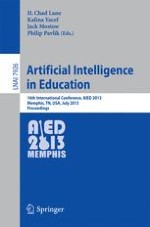This book constitutes the refereed proceedings of the 16th International Conference on Artificial Intelligence in Education, AIED 2013, held in Memphis, TN, USA in July 2013. The 55 revised full papers presented together with 73 poster presentations were carefully reviewed and selected from a total of 168 submissions. The papers are arranged in sessions on student modeling and personalization, open-learner modeling, affective computing and engagement, educational data mining, learning together (collaborative learning and social computing), natural language processing, pedagogical agents, metacognition and self-regulated learning, feedback and scaffolding, designed learning activities, educational games and narrative, and outreach and scaling up.
